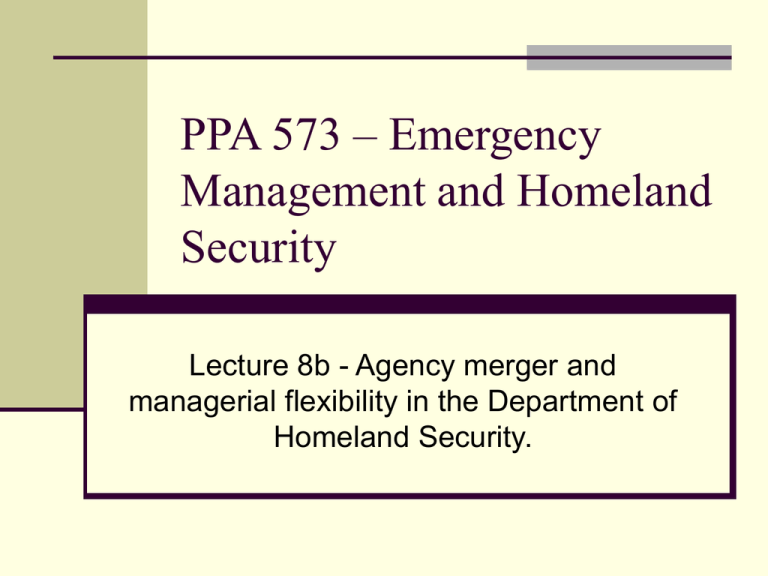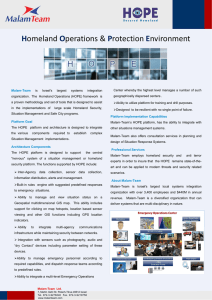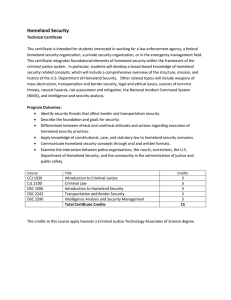PPA 573 – Emergency Management and Homeland Security
advertisement

PPA 573 – Emergency Management and Homeland Security Lecture 8b - Agency merger and managerial flexibility in the Department of Homeland Security. Introduction On June 6, 2002, President George W. Bush proposed the creation of the Department of Homeland Security (USDHS) as a new Cabinet department. After more than five months of debate and controversy, President Bush signed the Homeland Security Act on November 25, 2002. Introduction Mission of DHS: Prevent terrorist attacks within the United States. Reduce America’s vulnerability to terrorism. Minimize the damage and recover from attacks that do occur. Introduction The freedom to manage revolves around five central issues of presidential management. To what degree is effective leadership critical to the creation and implementation of DHS? To what degree should homeland security functions be centralized in a single agency in the national government or decentralized to state, local, nonprofit, and private organizations? To what degree does effective implementation require networking and coordination with governmental and nongovernmental partners? To what extent are the missions of the combined organizations compatible with one another and the overall mission of DHS? To what degree should the senior officials in DHS have the capacity to “get the right people in the right place at the right time with the right pay?” Critical Issues in Homeland Security Four critical issues. The development of a national strategy for homeland security. The use of risk assessment. The creation of a central leadership. The development of networking and coordination. Critical Issues in Homeland Security 1. The development of a national strategy for homeland security. The Bush administration published the first national strategy in July 2002. A concerted national effort to prevent terrorist attacks within the United States, reduce vulnerability to terrorism, and minimize the damage and recover from attacks that do occur. Five major functions. Intelligence and warning. Perimeter defense. Domestic prevention. Protection of significant national assets. Consequence management. Critical Issues in Homeland Security 2. The use of risk assessment. No homeland security strategy is comprehensive enough to identify all threats and protect all potential targets. Any attempt to achieve total security will not only fail, but will undermine other critical values such as civil rights and liberties. The ultimate goal is the identification of practical and feasible homeland security strategies that focus on the identification and protection of critical assets. The primary tools is risk management. Threat assessment. Vulnerability assessment. Criticality assessment. Critical Issues in Homeland Security 3. The lack of central leadership. Most assessments prior to DHS criticized the lack of central leadership. But, homeland security is a decentralized activity whose success depends on the coordinated actions of dozens of organizations and hundreds of individuals. Terrorists are strategic actors, so counterterrorism must be strategic, which usually means some decentralization. Critical Issues in Homeland Security The intergovernmental and coordinative nature of homeland security. Each of the five functions of the national strategy require some input or deliberate action by state agencies, first responders, nonprofit organizations, or the public. Strategic Management in Homeland Security The overall success of the homeland security strategy will necessitate the application of a strategic management approach to any new organization created to oversee homeland security policy. Strategic Management in Homeland Security The USGAO has identified several elements critical to the implementation of new organizations. Strategic planning. Organizational alignment. Communications. Building partnerships. Performance management. Human capital strategy. Information management and technology. Knowledge management. Financial management. Acquisition management. Risk management. Change management. Implementation of the Department of Homeland Security The central strategy adopted by the Bush Administration to achieve the goals of homeland security and implement the national strategy is the Department of Homeland Security. Implementation of the Department of Homeland Security Figure . Organization of the Department of Homeland Security Source: Department of Homeland Security Web Site: www.dhs.gov. Implementation of the Department of Homeland Security The new agency combined twenty-two different programs from nine Cabinet departments and independent agencies. The agency contained 170,000 employees prior to the hiring of 30,000 to 40,000 transportation screeners by TSA. Implementation of the Department of Homeland Security Table 1. DHS Organizational Elements Identified by USGAO. Element Directorate for Information Analysis and Infrastructure Protection Mission Analyze law enforcement and intelligence information from federal, state, an d local government agencies, and private sector entities to identify and assess threats and vulnerabilities, and identify priorities for protective and support measures. Develop a comprehensive national plan for securing key resources and critical infrastructure. Administer the Homeland Security Advisory System. Directorate of Science and Technology Develop a national policy and strategic plan to identify and develop countermeasures for chemical, biological, radiological, nuclear, and other terrorist threats. Assess and test vulnerabilities and possible threats. Conduct basic and applied research and related activities. Directorate of Border and Transportation Security Directorate of Emergency Preparedness and Response Major agencies included National Infrastructure Protection Center (FBI) National Communications System (Defense) Critical Infrastructure Assurance Office (Commerce) National Infrastructure Simulation and Analysis Center (Energy) Federal Computer Incident Response Center (GSA) National Bio-weapons Defense Analysis Center (Defense) Plum Island Animal Disease Center (USDA) Chemical and biological national security nonproliferation program, nuclear proliferation programs, and nuclear assessment programs (Energy) Environmental Measurements Laboratory (Energy) Advanced scientific computing research programs and activities (Energy) Prevent entry of terrorists and terrorist instruments. Customs Service (Treasury) Secure the borders, waters, ports, terminals, waterways Transportation Security Administration (Transportation) and air, land, and sea transportation systems. Carry out Federal Protective Service (GSA) immigration enforcement functions and provide Federal Law Enforcement Training Center (Treasury) citizenship and immigration services. Establish and Office for Domestic Preparedness (Justice) administer rules governing visas or other forms of entry. Immigration and Naturalization Service (Justice) Ensure effectiveness of emergency response providers to Federal Emergency Management Agency terrorist attacks, major disasters, and other emergencies. Integrated Hazard Information System Provide the federal response to terrorist attacks and major National Oceanic and Atmospheric Administration disasters and aid in the recovery. Build a national National Domestic Preparedness Office (FBI) incident management system. Develop a national Domestic Emergency Support Teams (Justice) response plan. Emergency preparedness, national disaster, and medical response systems (HHS) Strategic National Stockpile (HHS) These entities are transferred intact and report directly to the DHS Secretary. They retain their current missions. Coast Guard Secret Service Source: USGAO 2002g, 22 Implementation of the Department of Homeland Security The framework in Table 1 clearly suggests that the Bush Administration intends to implement DHS using a strategic management focus. But, six critical areas remain that may complicate the successful implementation of DHS. Effective leadership. Networking and coordination. Mission compatibility. Managerial flexibility. Information management. Acquisition management. The first four are examined here. Implementation: Effective Leadership The impulse to centralization is apparent in the Homeland Security Act of 2002 and the 9/11 Commission recommendations. The urge to consolidate increases accountability to the President, simplifies communications in some ways, improves implementation by putting similar functions under a single structure, and grants statutory and budget authority to a single agency. The Act gives DHS considerable powers. The Act centralizes all management functions under the Undersecretary for Management. Creates management team with Chief Financial Officer, Chief Information Officer, Chief Human Capital Officer. Authorizes DHS and OPM to create a flexible and contemporary human resource management system. Draft regulations issued February 25, 2004. Implementation: Effective Leadership The Act and agency confront two critical problems that make coordination and catalytic leadership skills critical. Over 100 agencies had homeland security functions; only 22 were combined in DHS. The other activities must be coordinated. Most of the functions of homeland security are carried out by state and local governments, nonprofit organizations, and private organizations. Homeland security is an ill-structured problem with competing problem definitions Centralized leadership tends not to be effective. Catalytic leadership is more effective but also more time-consuming. Implementation: Networking and Coordination Complicating the leadership problem is the high demand for networking and coordination required by DHS. 87,000 governments governed by 500,000 elected officials. Advantages of dispersed expertise, but disadvantages of fragmented response and duplicative effort. Private sector owns 75% of critical infrastructure. Implementation: Networking and Coordination National strategy provides some recommendations for coordination, but much of the infrastructure for the coordination remains to be developed. First responders, proprietary information, corporate liability. Implementation: Successful Reorganization and Mission Compatibility. Critical factors for successful reorganization. Integrated approach. Specific, identifiable goals. Appropriate vehicle for accomplishing the goals. Successful implementation. Oversight. Implementation: Successful Reorganization and Mission Compatibility. Critical factors in homeland security reorganization. A national homeland security strategy that identifies and integrates critical functions. A well-defined homeland security mission with measurable outcomes. A well-thought-out discussion of the appropriate organizational structure. Implementation with committed leadership, key principles, implementation goals and timelines, implementation team, performance management system, communication system, and employee involvement. Oversight by agency leadership. Implementation: Successful Reorganization and Mission Compatibility. Table 1. Significant Non-Homeland Security Functions in DHS Component Agencies Agency Federal Emergency Management Agency U.S. Coast Guard Immigration and Naturalization Service U.S. Customs Service U.S. Secret Service Animal and Health Inspection Service HHS CBRN programs Lawrence Livermore and Environmental Measurements Laboratories Federal Protective Service Transportation Security Administration Federal Law Enforcement Training Center Office of Domestic Preparedness Nuclear Incident Response Team Domestic emergency support teams National Domestic Preparedness Office Energy CBRN Countermeasures Programs National Biowarfare Defense Analysis Center Critical Infrastructure Assurance Office Federal Computer Incident Response Center National Communications System National Infrastructure Protection Center National Infrastructure Simulation and Analysis Center and Energy Security and Assurance Program Source: Authors’ Analysis and USGAO 2002e Non-homeland security functions Mitigation, preparedness, response, and recovery to natural disasters Maritime safety and drug interdiction Citizenship and immigration services Collection of commercial tariffs Counterfeiting and presidential protection Agricultural inspection Public health research Advanced energy and environmental research None or limited None or limited None or limited None or limited None or limited None or limited None or limited None or limited None or limited None or limited None or limited None or limited None or limited None or limited Degree of incompatibility to homeland security High High High High Moderate Moderate Moderate Moderate Low Low Low Low Low Low Low Low Low Low Low Low Low Low Implementation: Successful Reorganization and Mission Compatibility. The agencies with the most critical incompatibility problems. FEMA, Coast Guard, INS, Customs. Secret Service, Animal and Health Inspection Service, HHS CBRN programs, National Labs. The general problem: Agency consolidation uses critical resources. GAO argues that the typical consolidation reduces effectiveness for 5 to 7 years. Larger consolidations take longer. DoD has taken 39 years. Implementation: Managerial Flexibility Problems in federal organization requiring more managerial flexibility. Insufficient workforce capacity. Ineffective management. Lack of a results-oriented culture. Implementation: Managerial Flexibility Flexibilities actually used in new regulations. * Pay and performance management. Broad pay bands would replace the 15-grade General Schedule (GS) system in place since 1949 in much of the federal civil service. Ten to 15 occupational pay clusters of similar jobs types would include four pay bands ranging from entry level to supervisor. The GAO recommended that the DHS use validated core competencies as a key part of evaluating individual contributions to departmental results. “The bottom line for additional performance-based pay flexibility,” said the GAO, “is that an agency should have to demonstrate that it has a modern, effective, credible and, as appropriate, validated performance management system in place with adequate safeguards.” * Adverse actions and appeals. Employees would be encouraged to use alternative dispute resolution (ADR) programs to resolve appeals. However, the process to identify mandatory-removal offenses must be collaborative and transparent, under the planned system. The GAO report warned the DHS to be cautious about defining specific actions requiring employee removal and to learn from the Internal Revenue Service’s (IRS) implementation of its mandatory-removal provisions. According to the GAO, IRS officials believed that these provisions had a negative impact on employee morale and effectiveness and had “a ‘chilling’ effect on IRS frontline enforcement employees who are afraid to take certain appropriate enforcement actions.” * Labor relations. The proposed regulations recognize employees’ right to organize and bargain collectively but reduce the areas subject to bargaining. It is critical to involve employees continually in a meaningful manner, the GAO advised. Implementation: Summary The Bush administration has provided the agency with a range of tools to maximize the exercise of effective leadership. But, the nature of homeland security may require catalytic leadership. The intergovernmental and interorganizational reality of homeland security will place a premium on networking. The networks do not exist. Implementation: Summary The numerous non-homeland security functions may be compromised despite statutory requirements. Managerial flexibility may give the agency needed leverage, but at the risk of political controversy. Findings 1a: The nature of the terrorist threat will require an agency and a centralized leadership that will allow quick decisions and flexible response. 1b: The intergovernmental and interorganizational structure of the homeland security system will require catalytic leadership that is collaborative, deliberative, and consensual. Findings 2. The current system provides insufficient incentives for the development of publicprivate partnerships. 3. DHS contains significant non-homeland security functions especially in Customs, FEMA, INS, and Coast Guard. 4. The new agency contains several agencies with severe managerial problems identified by USGAO. Findings 5. The managerial flexibilities granted in the Homeland Security Act will allow the Department to create a more flexible human resource system over the next five years. 6. The exercise of personnel flexibilities by the Department will be subject to political controversy and may lead to decreased productivity and morale. Recommendations 1. The Secretary of Homeland Security should develop a strategic plan for the Department with the collaboration of the key homeland security stakeholders. 2. Strategic human capital management should be a critical component of this plan. 3a. In the short term, the human capital plan should focus on the personnel flexibilities currently available under federal law, including those added in the Homeland Security Act. Recommendations 3b. Other personnel flexibilities should only be pursued with the consultation with employee representatives required under the Act. 3c. The President and the Secretary of Homeland Security should not use the national security provisions of Title V to decertify the existing public sector unions in DHS. Recommendations 4. DHS should accelerate the identification of critical infrastructure and the development of the corresponding public-private partnerships. 5. The DHS strategic plan will need to explicitly identify non-homeland security functions and outcomes and provided adequate mechanisms and resources to assure continued high levels of performance. 6. DHS should prepare for homeland security failures within the next five years.







